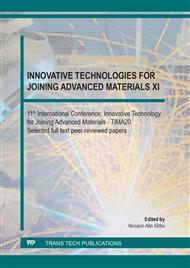[1]
R.S. Mishra, M.W. Mahoney, Friction Stir Welding and Processing, ASM International, The Materials Information Society, Ohio, USA (2007).
Google Scholar
[2]
Chun Yip Chan, Friction stir processing of Aluminum-Silicon Alloys, PhD Thesis, The University of Manchester, UK (2011).
Google Scholar
[3]
M.S. Weglowski, Friction stir processing - State of the art, Arch. Civ. Mech. Eng, Vol. 18, Issue 1, January (2018), pp.114-129.
Google Scholar
[4]
V. Verbițchi, a.o., Weld surfacing of industrial valves. Equipment and technology experiments, Journal Armatura, CRIA, Romanian Committee for the Valve Industry, Valahia University of Targoviste, Romania, January (2003).
Google Scholar
[5]
A. C. Murariu, A. Perianu, Influence of HVOF deposition thickness on adhesion strength of WC–CrC–Ni coatings, The 4th IIW South –East European Welding Congress, SEEIIW 2018, October 10-13, Belgrade, Serbia (2018).
DOI: 10.24867/atm-2019-1-006
Google Scholar
[6]
V. Bîrdeanu, a.o., Investigations of corrosion behavior on combined fast laser texturing and HVOF TiO2 powder deposition surface engineering treatment, The 9th International Conference Innovative technologies for joining advanced materials, TIMA 18, Timisoara, Romania 1-2 November (2018).
DOI: 10.4028/www.scientific.net/amr.1153.119
Google Scholar
[7]
L. N. López De Lacalle, G. Urbikain Pelayo, I. Azkona, a.o., Functional Layers of Aluminum Alloy on Steel Made by Alternative Friction Processes, for Elements of Metal Structures, Adv. Mat. Res., ISSN: 1662-898, Vol. 1146, pp.106-114, © 2018 Trans Tech Publications, Switzerland.
DOI: 10.4028/www.scientific.net/amr.1146.106
Google Scholar
[8]
R. Stevenson, Pei-Chung Wang, Patent No. US 6,988,651, B2, 2006, Friction Stir Rivet Drive System and Stir Riveting Methods, General Motors Corporation, Detroit (2006).
Google Scholar
[9]
Genze Ma, Friction Stir Riveting: Characteristics of Friction Stir Riveted Joints, PhD Thesis, University of Toledo (2012).
Google Scholar
[10]
R. Stevenson, Pei-Chung Wang, Patent No. US 6,883,699, B2, 2005,Rivet with sliding cap for friction stir riveting, General Motors Corporation, Detroit (2005).
Google Scholar
[11]
R. Stevenson, Pei-Chung Wang, Patent No. US 6,892,924, B2, 2005 – Processing rivet and method for friction stir riveting, General Motors Corporation, Detroit (2005).
Google Scholar
[12]
Pei-Chung Wang, R. Stevenson, Patent No.US 7,862,271, B2, 2011 – Friction stir rivet method of joining, General Motors Corporation, Detroit (2011).
Google Scholar
[13]
J.R. Trinick, Patent No.US 8,898,880 – Self-piercing riveting, Flintshire, GB (2014).
Google Scholar
[14]
R.S. Wright, a.o., Patent No.US 9,162,332 – Method and apparatus for automated multi-drilling and multi-rivet machine, Boeing Company, Chicago (2015).
Google Scholar
[15]
S.F. Golovashchenko, Patent No.US 9,168,581– Electro-hydraulic rivet and method of riveting and welding parts, Ford Global Technologies (2015).
Google Scholar
[16]
S. T. Amancio Filho, M. Beyer, J. F Dos Santos, Verfahren zum verbindem eines metallischen Bolzens mit einem Kunststoff-Werkstück, DE Patent Application Nr. 10 2005 056 606 A1 (2007).
Google Scholar
[17]
L. Blaga, PhD Thesis: Innovating materials in bridge construction. Contributions to construction with composite fiber reinforced materials., UPT Timisoara and Helmholz Centrum Geesthacht Germany, http://www.upt.ro/administrare/dgac1/file/2011-2012/doctorat/teze/BlagaLucianSinteza.pdf, (2012).
Google Scholar
[18]
L. Blaga. J dos Santos, R. Băncilă, S. T. Amancio Filho, Friction Riveting (FricRiveting) as a new joining technique in GFRP lightweight bridge construction, Constr. Build. Mater., Vol. 80, http://www.sciencedirect.com/science/article/pii/S0950061815000148, April 2015, pp.167-179.
DOI: 10.1016/j.conbuildmat.2015.01.001
Google Scholar


